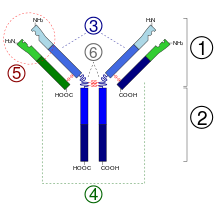Paratope

2. Fc region
3. Heavy chain
4. Light chain with one variable (VL) and one constant (CL) domain
5. Fc region with paratope
6. Hinge regions
A paratope, also called an antigen-binding site, is a part of an antibody which recognizes and binds to an antigen. It is a small region (of 5 to 10 amino acids[citation needed]) of the antibody's Fab region, part of the fragment antigen-binding (Fab region), and contains parts of the antibody's heavy and light chains.[1] Each arm of the Y shape of an antibody monomer is tipped with a paratope, which is a set of 6 complementarity-determining regions (CDR loops) - 3 of each light and heavy chain extending from the fold of antiparallel beta sheets.
The part of the antigen to which the paratope binds is called an epitope. This can be mimicked by a mimotope. The figure given on the right hand side depicts the antibody commonly found on a B leukocyte. The engraved inner portions of idiotype (encircled region no.5 in the above diagram) is the paratope where the epitope of the antigen binds.
References
- ^ Goldsby, Richard; Kindt, TJ; Osborne, BA; Kuby, Janis (2003). "Antigens (Chapter 3)". Immunology (Fifth ed.). New York: W. H. Freeman and Company. pp. 57–75. ISBN 0716749475.
